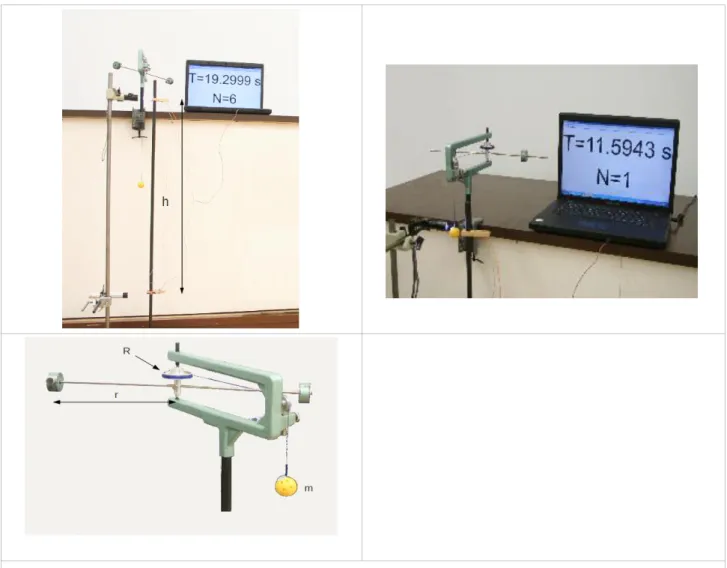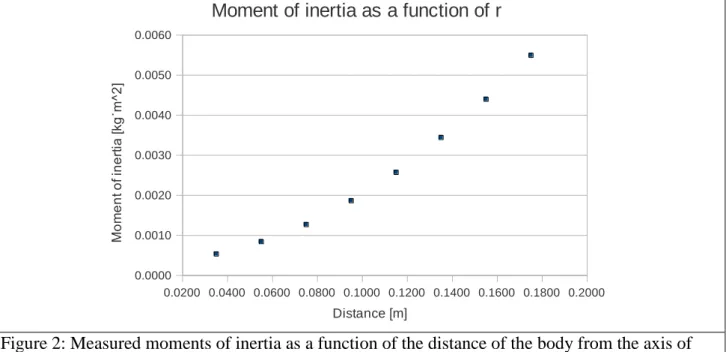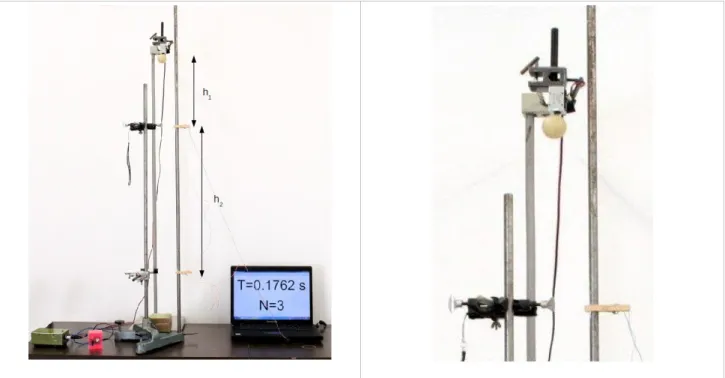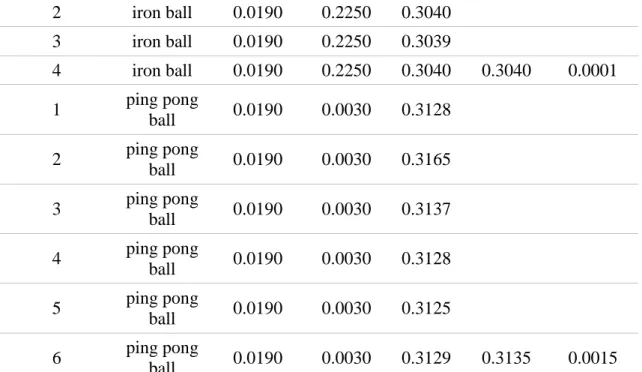Katalin Kopasz, Peter Makra, Zoltan Gingl:
Measurements with a sound card
Student experiments and measurements are important and efficient tools to increase interest in physics classes. Because of the low number of the classes, the more complex experiments are usually pushed into the background. Virtual measurements – where the experiments are real, but the bulk of data processing is realised in software – could help to solve the problem. Students can also see that they can use computers not only for playing games, but also as tools with which they can quickly produce charts to analyse and thus improve their skills.
Our simple but high-resolution stopwatch [1] allows us to carry out accurate measurements easily in the classroom. We show two examples where accurate time measurement offers new perspectives in secondary-school experiments.
An experimental study of rotational motion
Using conventional instruments we can demonstrate Newton's second law for rotation. A simple example is shown in Figure 1. A light disc is mounted on the rigid rotational axis of a rigid rod (which ends in two small bodies). A light string is wrapped around the edge of the disc, and a ballast is suspended at its free end. After letting go of the hanging body it falls with a uniformly changing velocity, while the rod rotates with a constant acceleration.
Figure 1: A conventional instrument for demonstrating Newton's second law for rotation
The moment of inertia (I) can be determined from the mass of the hanging body (m), the radius of the disc (R), the displacement of the body (h) and time of motion (t).
Newton's second law for rotation is
,
I
where τ denotes torque and α is the angular acceleration. The latter we can obtain from
2
2 t R
h R
a
.
Newton's second law for the hanging body is
, ma F mg
where F is the tension force in the thread acting on the body moving with acceleration a.
Using F to describe the rotational law is
g aR m
R
F
,
from which, substituting α, we can calculate I:
2 2
2 2
2 2
2 2
2
2 2
2 2
2 2
2 Rt
R h h
t R m h
t R g m h
R t
R m h
t R g m h
t R R a g I m
2 2
2 2
2
R m R g m R m h
t R g m
I
Sound card stopwatch techniques offer new perspectives in studying rotational motion, especially in determining the moment of inertia of particles. Using a stopwatch is a unique possibility because this experimental setup does not allow measuring time more accurately in other ways (e.g. by increasing the height).
Changing the distance of the body (placed originally to the end of the rod) from the axis of the rod we can get the relationship between distance and moment of inertia. Our results are summarised in Table 1. We also present two graphs: the first one shows the moment of inertia as a function of distance (Fig 2), while on Figure 3 there are the squares of distances on the x axis. It is easy to see that the linearised curve intersects the y axis above zero: this is caused by the moment of inertia of the rod.
Table 1: Measured moments of inertia as a function of distance of the body from the axis of the rod
Mass Height Time Distance
m [kg] r [m] h2 [m] t [s] R [m] R^2 [m^2]
0.0060 0.0200 0.6900 4.1140 4.0769 0.0003
0.0060 0.0200 0.6900 5.6176 2.1865 0.0005 0.0350 0.0012
0.0060 0.0200 0.6900 7.0427 1.3911 0.0008 0.0550 0.0030
0.0060 0.0200 0.6900 8.6372 0.9249 0.0013 0.0750 0.0056
0.0060 0.0200 0.6900 10.4624 0.6304 0.0019 0.0950 0.0090
0.0060 0.0200 0.6900 12.2868 0.4571 0.0026 0.1150 0.0132
0.0060 0.0200 0.6900 14.2124 0.3416 0.0034 0.1350 0.0182
0.0060 0.0200 0.6900 16.0603 0.2675 0.0044 0.1550 0.0240
0.0060 0.0200 0.6900 17.9504 0.2141 0.0055 0.1750 0.0306
Radius of the dial
Angular acceleratio
n
Moment of inertia
Square of the distance b [1/s*s] Q [kg*m*m]
0.0200 0.0400 0.0600 0.0800 0.1000 0.1200 0.1400 0.1600 0.1800 0.2000 0.0000
0.0010 0.0020 0.0030 0.0040 0.0050 0.0060
Moment of inertia as a function of r
Distance [m]
Moment of inertia [kg˙m^2]
Figure 2: Measured moments of inertia as a function of the distance of the body from the axis of the rod
0.0000 0.0050 0.0100 0.0150 0.0200 0.0250 0.0300 0.0350 0.0000
0.0010 0.0020 0.0030 0.0040 0.0050 0.0060
f(x) = 0.16912x + 0.00033
Moment of inertia as a function of r^2
Square of the distance [m^2]
Moment of inertia [kg˙m^2]
Figure 3: Moment of inertia as a function of the squares of the distances
Studying the motion of free-falling bodies
Using a sound card and some free software, Ganci [2] produced convincing results in measuring the value of the local gravitational acceleration in the classroom.
Hunt and Dingley [3] also exploited the accuracy of sound card measurements to study the bouncing of different balls.
Considering drag force and buoyant force, we can apply the dynamic equation for a free-falling ball:
b d F F g m
= a
m ,
where Fd is the drag force and Fb is the buoyant force. The former can be calculated from the volume of the body and the density of the medium:
g V
=
Fb air ball
The magnitude of the drag force – depending on the velocity and size of the body and on the properties of the medium – is proportional to the velocity (F=6πηrv) or to its square
2 2
1
v ρA c
=
Fd .
In both cases, the acceleration (as well as the fall time) of the body depends on the mass.
Linear drag:
v m
ηr π m
g ρ V
g
=
a air
6
Quadratic drag:
2
2
v m
ρ A c m
g ρV
g
=
a air air air
We expect in both cases that the ball with larger mass will have a shorter fall time. Dropping bodies with the same mass but with different volumes, the difference of fall times is measurable only under special circumstances (e.g. with balls dropping from a high tower). However, using a sound card stopwatch makes it possible also in the classroom. At first we were wondering if the difference of fall times of an iron ball and a ping pong ball is measurable or not. We fastened a pin to latter, while to ensure the accurate timing of the start, we used an electromagnet disassembled from an old photocopier.
Figure 4: Experimental arrangement by studying free-falling balls
In the first arrangement, the height of fall between the place of start and the first gate (h1) was 30.4 centimetres, while the distance of the two gates (h2) was 58.5 cm (fall times were measured in the latter section).
Table 2 shows the results: the fall times of the iron ball are clearly shorter, and the errors of the measurements are very small.
Number of
measurements Falling ball
Radius of the ball [m]
Mass of the ball
[kg]
Time [s] Average [s]
Standard deviation
[s]
1 iron ball 0.0190 0.2250 0.1763 2 iron ball 0.0190 0.2250 0.1763
3 iron ball 0.0190 0.2250 0.1762 0.1763 0.0001
1 ping pong
ball 0.0190 0.0030 0.1845
2 ping pong
ball 0.0190 0.0030 0.1842
3 ping pong
ball 0.0190 0.0030 0.1853 0.1847 0.0006 Table 2: The first set of fall times
In the second arrangement, the first photogate was fixed directly at the level of the bottom of the balls. In that case, the displacement of the balls was 71.7 cm. This arrangement helps students to analyse the problem, because we can use the equations mentioned above with starting velocities equal to zero (which helps much to calculate the drag force and the buoyant force). We could also measure the differences of velocities in that case (see Table 3).
Number of
measurements Falling ball Radius of the ball [m]
Mass of the ball
[kg]
Time [s] Average [s]
Standard deviation
[s]
1 iron ball 0.0190 0.2250 0.3039
2 iron ball 0.0190 0.2250 0.3040
3 iron ball 0.0190 0.2250 0.3039
4 iron ball 0.0190 0.2250 0.3040 0.3040 0.0001
1 ping pong
ball 0.0190 0.0030 0.3128
2 ping pong
ball 0.0190 0.0030 0.3165
3 ping pong
ball 0.0190 0.0030 0.3137
4 ping pong
ball 0.0190 0.0030 0.3128
5 ping pong
ball 0.0190 0.0030 0.3125
6 ping pong
ball 0.0190 0.0030 0.3129 0.3135 0.0015
Table 3: The second set of fall times (the first photogate was fixed directly at the level of the bottom of the balls)
We have shown two experiments that take advantage of the accuracy of our devices to determine special physical parameters hard to measure with conventional techniques. Using our method, also applicable as an IBL programme, it is possible to teach these laws of Nature via student activity.
We have presented our results at the StepsTwo conference in Limassol, Cyprus in 2011 (http://www.stepstwo.ua.ac.be/wg3/cy/). We thank the StepsTwo Network for their support. This project is supported by the European Union and co-funded by the European Social Fund through the TÁMOP 4.2.2/B-10/1-2010-0012 grant.
References:
[1] Z Gingl, K Kopasz: A high-resolution stopwatch for cents 2011 Phys. Educ. 46 430-432.
[2] S. Ganci: Measurement of g by means of the ‘improper’ use of sound card software: a multipurpose experiment 2008 Phys. Educ. 43 297-300.
[3] M B Hunt and K Dingley: Use of the sound card for datalogging 2002 Phys. Educ. 37 251-253.




